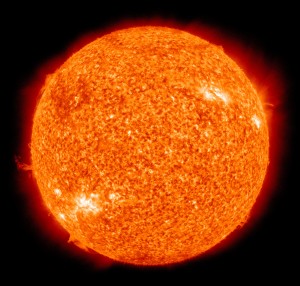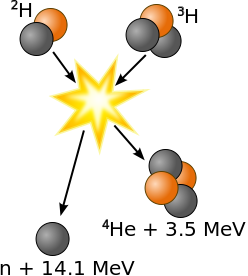When people hear the term ‘nuclear’ they view it as a negative and dangerous field of technology that can create large problems due to radiation and improper disposal of radioactive waste. Most non-war applications of nuclear technology are around the generation of electricity through nuclear fission, the other method, using nuclear fusion to generate electricity, is still very much experimental but that might change with new fusion reactor designs.

The sun produces its energy through nuclear fusion; Image Courtesy of Wikimedia Commons
While generating electricity from nuclear power plants is a topic of debate due to safety (a very prominent disaster was the Chernobyl reactor meltdown) and waste product concerns it is important to understand that most nuclear facilities use nuclear fission, splitting a large atom, to generate their power. The method of nuclear fusion on the other hand is opposite in the way that it involves fusing smaller atoms to create a larger atom and is much safer due to the different starting materials and products created.

A diagram showing the fusion reaction of two common fusion reactants Deuterium and Tritium; Image Courtesy of Wikimedia Commons
When comparing nuclear fusion and fission we see that although they both involve working with atoms their energy consumption and production are vastly different as well as the by-products created. Nuclear fusion both creates less radioactive waste as well as producing more energy than nuclear fission; but the catch with nuclear fission is that due to the large amount of energy required to start a fusion reaction currently energy production from fusion reactors is in an experimental stage.
Currently, in an effort to push nuclear fusion energy forward, the International Thermonuclear Experimental Reactor (ITER) is being built in France based off the Tokamak design style. The ITER is expected to work but is a very large reactor and for fusion power to become the future smaller reactors will need to be possible.
Fortunately the company of Lockheed Martin has released more details on an experimental fusion reactor prototype that could make fusion power a common reality. They are in the process of designing a compact fusion reactor using their own designs. The compact fusion reactor (CFR) being designed is expected to be ten times smaller while producing the same power output as a Tokamak styled reactor, like the ITER. Currently the Lockheed Martin project is still in early stages but the designers are hopeful that they will be able to produce an early prototype in 5 years. While 5 years might seem like a long time the main thing is that fusion reactors are much closer to becoming a reality than they were before.

The ability to have the massive energy produced by fusion reactors in a compact design means that energy intensive processes such as desalination would be much more affordable and the CFR could even be installed into ships or applied to providing power to cities. With the CFR it could open doors to provide sustainable energy to the world.
– Matthew Leupold
